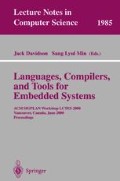Abstract
Low energy consumption is becoming the primary design consideration for battery-operated and portable embedded systems, such as personal digital assistants, digital still and movie cameras, digital music playback, medical devices, etc. For a typical processor-based system, the energy consumption of the processor-memory component is split roughly 40–60% between the processor and memory. In this paper, we study the impact of reordering memory bus traffic on reducing bus switching activity and power consumption. To conduct this study, we developed a software tool, called MPOWER, that lets an embedded system designer collect a trace of memory bus accesses and determine the switching activity of the trace, given design parameters such as data and address bus width, bus multiplexing, cache size, block size, etc. Using MPOWER, we measured the effectiveness of reordering memory accesses on switching activity. We found that for small caches, which are typical of embedded processors, the number of signal transitions in an ideal case can be reduced by an average of 53%. This paper also describes a practical hardware scheme for reordering the elements within a cache line to reduce switching activity. We found that cache line reordering reduces switching activity by 15–31%.
Access this chapter
Tax calculation will be finalised at checkout
Purchases are for personal use only
Preview
Unable to display preview. Download preview PDF.
References
Bahar R. I., Albera G. and Manne S., “Power and performance trade-offs using various Caching Strategies”, Int’l. Symp. on Low-Power Electronics and Design, pp. 64–69, Monterey, CA, August 1998.
Bellas N., Hajj I., and Polychronopoulos, “Architectural and compiler support for energy reduction in the memory hierarchy of high performance microprocessors”, Int’l. Symp. on Low-Power Electronics and Design, pp. 70–75, Monterey, CA, August 1998.
Bunda J., Fussell D., Athas W. C., Jenevein R., “16-bit vs. 32-bit instructions for pipelined microprocessors”, ACM/IEEE Int’l. Symp. on Computer Architecture, pp. 237–246, San Diego, CA, May 1993.
Burger D. and Austin T. M., “The SimpleScalar tool set, version 2.0”, Technical Report #1342, Computer Science Department, University of Wisconsin-Madison, June 1997.
Chandrakasan A. and Brodersen R., Low Power Digital CMOS Design, Kluwer Academic Publishers, 1995.
Chang J. and Pedram M., “Register allocation and binding for low power”, 32 nd ACM/ IEEE Design Automation Conference, pp. 29–35, 1995.
Cooper K. D. and Harvey T. J., “Compiler-controlled memory”, 8th ACM Int’l. Conference on Architectural Support for Programming Languages and Operating Systems, pp. 2–11, October 1998.
Cuppu V., Jacob B., Davis B., and Mudge T., “A performance comparison of contemporary DRAM architectures”, ACM/IEEE Int’l. Symp. on Computer Architecture, pp. 222–233, Atlanta, GA, May 1–5, 1999.
Diguet J., Wuytack S., Catthoor F. and Man H. D., “Formalized methodology for data reuse exploration in hierarchical memory mappings”, Int’l. Symp. on Low-Power Electronics and Design, pp. 30–35, Monterey, CA, August 1997.
Fromm R., Perissakis S., Cardwell N., et al., “The energy efficiency of IRAM architectures”, ACM/IEEE Int’l. Symp. on Computer Architecture, pp. 327–337, Denver, CO, June 1997.
Gowan M. K., Biro L. L., and Jackson D. B., “Power considerations in the design of the Alpha 21264 microprocessor”, 35 th ACM/IEEE Design and Automation Conference, pp. 726–731, San Francisco, CA, June 1998.
Hunt D. and Lesartre G., “PA-8500: The continuing evolution of the PA-8000”, IEEE Computer Conference, San Jose, CA, February 1997.
Kessler R. E., “The Alpha 21264 microprocessor”, IEEE Micro, Vol. 19, No. 2, pp. 24–36, March/April 1999.
Jouppi N., “Improving direct-mapped cache performance by the addition of a small fully-associative cache and prefetch buffers”, ACM/IEEE Int’l. Symp. on Computer Architecture, pp. 364–373, May 1990.
Kin J., Gupta M., and Mangione-Smith W. H., “The filter cache: A energy efficient memory structure”, IEEE/ACM 30 th Int’l. Symp. on Microarchitecture, pp. 184–193, Research Triangle Park, NC, December 1997
Lee C., Potkonjak M., and Magione-Smith W. M., “MediaBench: A tool for evaluating and synthesizing multimedia and communication systems”, IEEE/ACM 30 th Int’l. Symp. on Microarchitecture, pp. 330–335, RTP, NC, December 1997.
Lee M., Tiwari V., Malik S., and Fujita M., “Power analysis and low-power scheduling techniques for embedded DSP software”, IEEE/ACM Int’l. Symp. on Systems Synthesis, pp. 110–115, Cannes, France, September 1995.
Lefurgy C., Piccininni E., and Mudge T., “Evaluation of a high performance code compression method”, IEEE/ACM 32 nd Int’l. Symp. on Microarchitecture, pp. 93–102, Haifa, Israel, November 1999.
MCORE MMC2001 Reference Manual, Motorola Semiconductor Product Sector, Austin, Texas, http://www.motorola.com/SPS/MCORE, 1998.
Motorola PowerPC MPC7400 User’s Manual, document number MPC7400UM/D, Motorola Semiconductor Product Sector, Austin, Texas, http://www.motorola.com/SPS, 2000.
Quan M., “Chip makers reap benefits of cell-phone boom”, EE Times, http://www.eetimes.com, Nov. 18, 1999.
Santhanam S., “StrongARM SA110: A 160 MHz 32b 0.5W CMOS ARM processor”, HotChips VIII, pp. 119–130, Stanford, CA, August 1996.
Su C-L, Tsui C-Y, and Despain A. M., “Low power architecture design and compilation techniques for high-performance processors”, IEEE Computer Conference, February 1994.
Tiwari V., Malik S. and Wolfe A., “Compilation techniques for low energy: An overview”, Int’l. Symp. on Low-Power Electronics, October 1994
Author information
Authors and Affiliations
Editor information
Editors and Affiliations
Rights and permissions
Copyright information
© 2001 Springer-Verlag Berlin Heidelberg
About this paper
Cite this paper
Childers, B.R., Nakra, T. (2001). Reordering Memory Bus Transactions for Reduced Power Consumption. In: Davidson, J., Min, S.L. (eds) Languages, Compilers, and Tools for Embedded Systems. LCTES 2000. Lecture Notes in Computer Science, vol 1985. Springer, Berlin, Heidelberg. https://doi.org/10.1007/3-540-45245-1_10
Download citation
DOI: https://doi.org/10.1007/3-540-45245-1_10
Published:
Publisher Name: Springer, Berlin, Heidelberg
Print ISBN: 978-3-540-41781-1
Online ISBN: 978-3-540-45245-4
eBook Packages: Springer Book Archive

